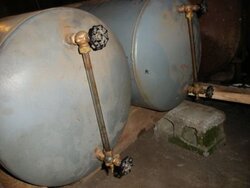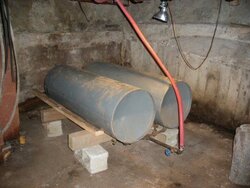Hi all, since I'll be isolating my stainless milk tank with a heat exchanger, I am wanting to go with a true sealed pressurized system for my boiler. BUT, my heat exchanger on my stove isn't designed for pressure..... The ends are 1/4" steel, the firetubes are schedule 40 pipe, and the front and sides are made from a single bent piece of 1/4"..... But the back is a piece of 3/16" steel that's welded to the top, bottom, and sides. Under 10-15 psi of pressure it bows out noticeably. I'm worried over what it would do if pressure were to hit 30psi (pop-off valve pressure)... So, instead of a bladder tank, I was thinking of using a plain steel tank with very little precharge pressure. But, the air will get ingested into the water over time, which has the same effect as an open system..
So, I was wondering if one could use welder shielding gas? I use Praxair's stargon which is 80% argon, 8% CO2, & 2% oxygen. Seems since it's safe for use in shielding melted metal, it ought to be ideal as an air charge for hydronic water since everything in it except for the 2% oxygen is considered metal inert gas. (Where the term MIG welding came from)
What do you all think?
My other option is to weld angle iron across the back of the stove to beef it up to handle higher pressure, which may be the better way to go...
Looking for feedback here.
So, I was wondering if one could use welder shielding gas? I use Praxair's stargon which is 80% argon, 8% CO2, & 2% oxygen. Seems since it's safe for use in shielding melted metal, it ought to be ideal as an air charge for hydronic water since everything in it except for the 2% oxygen is considered metal inert gas. (Where the term MIG welding came from)
What do you all think?
My other option is to weld angle iron across the back of the stove to beef it up to handle higher pressure, which may be the better way to go...
Looking for feedback here.



